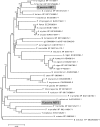Molecular regulation of arabinan and L-arabinose metabolism in Hypocrea jecorina (Trichoderma reesei)
- PMID: 19801419
- PMCID: PMC2794218
- DOI: 10.1128/EC.00162-09
Molecular regulation of arabinan and L-arabinose metabolism in Hypocrea jecorina (Trichoderma reesei)
Abstract
Hypocrea jecorina (anamorph: Trichoderma reesei) can grow on plant arabinans by the aid of secreted arabinan-degrading enzymes. This growth on arabinan and its degradation product L-arabinose requires the operation of the aldose reductase XYL1 and the L-arabinitol dehydrogenase LAD1. Growth on arabinan and L-arabinose is also severely affected in a strain deficient in the general cellulase and hemicellulase regulator XYR1, but this impairment can be overcome by constitutive expression of the xyl1 encoding the aldose reductase. An inspection of the genome of H. jecorina reveals four genes capable of degrading arabinan, i.e., the alpha-L-arabinofuranosidase encoding genes abf1, abf2, and abf3 and also bxl1, which encodes a beta-xylosidase with a separate alpha-L-arabinofuranosidase domain and activity but no endo-arabinanase. Transcriptional analysis reveals that in the parent strain QM9414 the expression of all of these genes is induced by L-arabinose and to a lesser extent by L-arabinitol and absent on D-glucose. Induction by L-arabinitol, however, is strongly enhanced in a Deltalad1 strain lacking L-arabinitol dehydrogenase activity and severely impaired in an aldose reductase (Deltaxyl1) strain, suggesting a cross talk between L-arabinitol and the aldose reductase XYL1 in an alpha-L-arabinofuranosidase gene expression. Strains bearing a knockout in the cellulase regulator xyr1 do not show any induction of abf2 and bxl1, and this phenotype cannot be reverted by constitutive expression of xyl1. The loss of function of xyr1 has also a slight effect on the expression of abf1 and abf3. We conclude that the expression of the four alpha-L-arabinofuranosidases of H. jecorina for growth on arabinan requires an early pathway intermediate (L-arabinitol or L-arabinose), the first enzyme of the pathway XYL1, and in the case of abf2 and bxl1 also the function of the cellulase regulator XYR1.
Figures







Similar articles
-
The D-xylose reductase of Hypocrea jecorina is the major aldose reductase in pentose and D-galactose catabolism and necessary for beta-galactosidase and cellulase induction by lactose.Mol Microbiol. 2007 Nov;66(4):890-900. doi: 10.1111/j.1365-2958.2007.05953.x. Epub 2007 Oct 9. Mol Microbiol. 2007. PMID: 17924946
-
D-xylose metabolism in Hypocrea jecorina: loss of the xylitol dehydrogenase step can be partially compensated for by lad1-encoded L-arabinitol-4-dehydrogenase.Eukaryot Cell. 2003 Oct;2(5):867-75. doi: 10.1128/EC.2.5.867-875.2003. Eukaryot Cell. 2003. PMID: 14555469 Free PMC article.
-
The metabolic role and evolution of L-arabinitol 4-dehydrogenase of Hypocrea jecorina.Eur J Biochem. 2004 May;271(10):1864-72. doi: 10.1111/j.1432-1033.2004.04088.x. Eur J Biochem. 2004. PMID: 15128296
-
[Transcriptional regulation of cellulases and hemicellulases gene in Hypocrea jecorina--a review].Wei Sheng Wu Xue Bao. 2010 Nov;50(11):1431-7. Wei Sheng Wu Xue Bao. 2010. PMID: 21268886 Review. Chinese.
-
Fungal arabinan and L-arabinose metabolism.Appl Microbiol Biotechnol. 2011 Mar;89(6):1665-73. doi: 10.1007/s00253-010-3071-8. Epub 2011 Jan 7. Appl Microbiol Biotechnol. 2011. PMID: 21212945 Free PMC article. Review.
Cited by
-
Identification of an L-arabinose reductase gene in Aspergillus niger and its role in L-arabinose catabolism.J Biol Chem. 2010 Jul 30;285(31):23622-8. doi: 10.1074/jbc.M110.113399. Epub 2010 May 28. J Biol Chem. 2010. PMID: 20511228 Free PMC article.
-
The putative protein methyltransferase LAE1 of Trichoderma atroviride is a key regulator of asexual development and mycoparasitism.PLoS One. 2013 Jun 24;8(6):e67144. doi: 10.1371/journal.pone.0067144. Print 2013. PLoS One. 2013. PMID: 23826217 Free PMC article.
-
The influence of feedstock characteristics on enzyme production in Trichoderma reesei: a review on productivity, gene regulation and secretion profiles.Biotechnol Biofuels. 2019 Oct 8;12:238. doi: 10.1186/s13068-019-1571-z. eCollection 2019. Biotechnol Biofuels. 2019. PMID: 31624500 Free PMC article. Review.
-
Cellulases and beyond: the first 70 years of the enzyme producer Trichoderma reesei.Microb Cell Fact. 2016 Jun 10;15(1):106. doi: 10.1186/s12934-016-0507-6. Microb Cell Fact. 2016. PMID: 27287427 Free PMC article. Review.
-
L-arabitol is the actual inducer of xylanase expression in Hypocrea jecorina (Trichoderma reesei).Appl Environ Microbiol. 2011 Sep;77(17):5988-94. doi: 10.1128/AEM.05427-11. Epub 2011 Jul 8. Appl Environ Microbiol. 2011. PMID: 21742908 Free PMC article.
References
-
- Alexiou, P., K. Pegklidou, M. Chatzopoulou, I. Nicolaou, and V. J. Demopoulos. 2009. Aldose reductase enzyme and its implication to major health problems of the 21(st) century. Curr. Med. Chem. 16:734-752. - PubMed
-
- Ausubel, F. M., B. Roger, R. E. Kingston, D. D. Moore, J. G. Seidman, J. Smith, and K. Struhl. 2006. Current protocols in molecular biology. Greene Publishing Associates/Wiley Interscience, New York, NY.
-
- Bhardwaj, A., and M. F. Wilkinson. 2005. A metabolic enzyme doing double duty as a transcription factor. Bioessays 27:467-471. - PubMed
-
- Carpita, N. C. 1996. Structure and biogenesis of the cell walls of grasses. Annu. Rev. Physiol. Plant Mol. Biol. 47:445-476. - PubMed
-
- Cho, Y. H., S. D. Yoo, and J. Sheen, J. 2006. Regulatory functions of nuclear hexokinase1 complex in glucose signaling. Cell 127:579-589. - PubMed
Publication types
MeSH terms
Substances
Grants and funding
LinkOut - more resources
Full Text Sources
Other Literature Sources
Molecular Biology Databases

